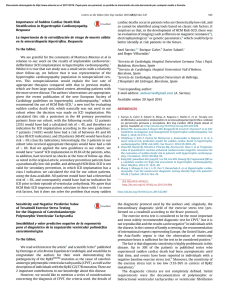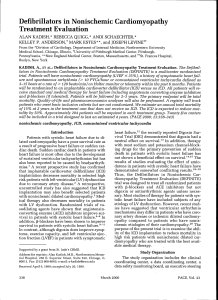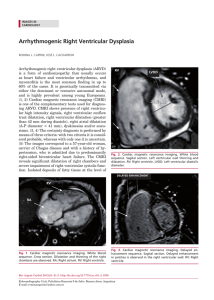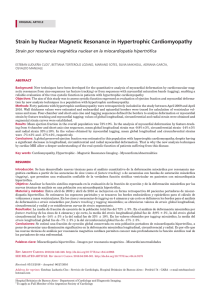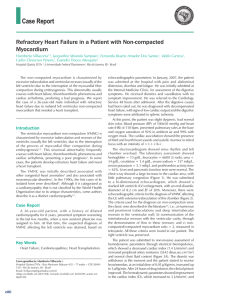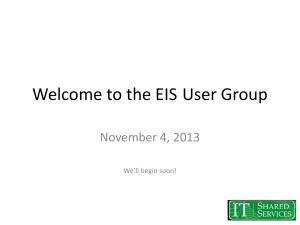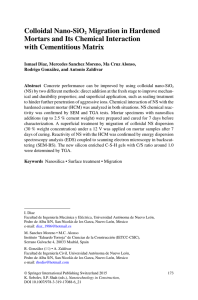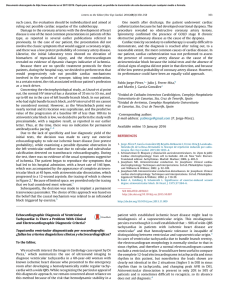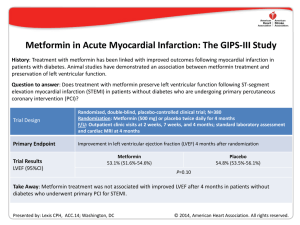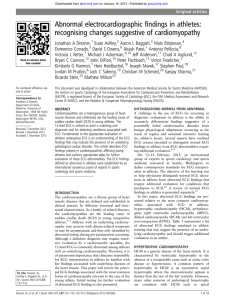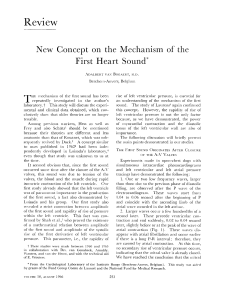Importance of Sudden Cardiac Death Risk Stratification in
Anuncio
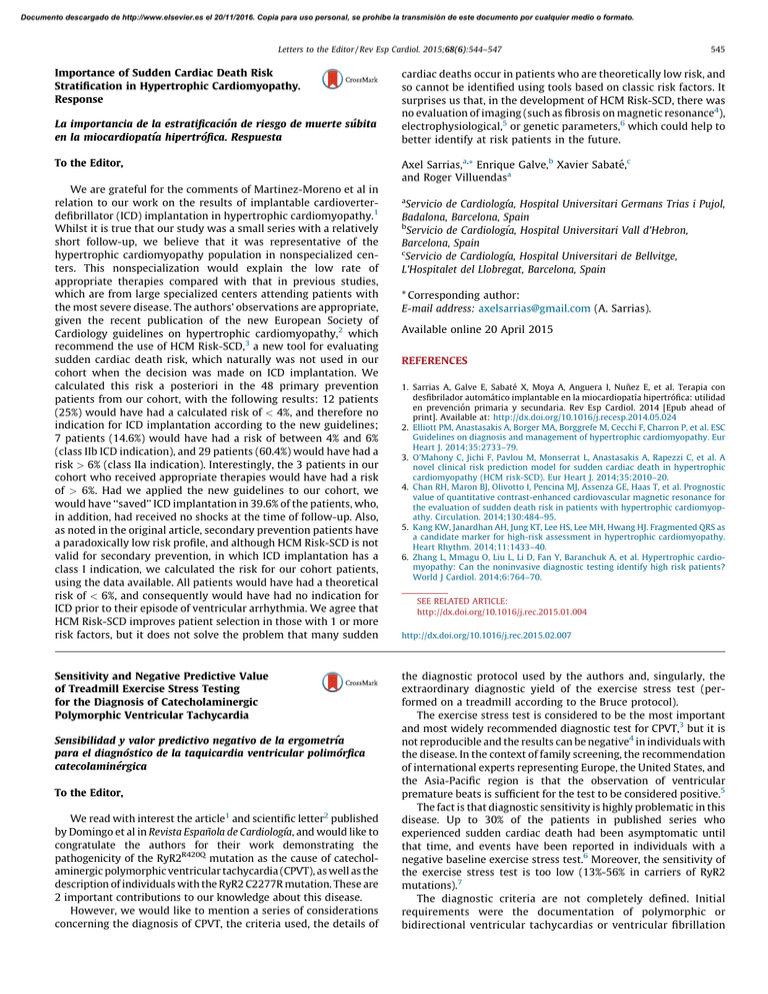
Documento descargado de http://www.elsevier.es el 20/11/2016. Copia para uso personal, se prohíbe la transmisión de este documento por cualquier medio o formato. Letters to the Editor / Rev Esp Cardiol. 2015;68(6):544–547 Importance of Sudden Cardiac Death Risk Stratification in Hypertrophic Cardiomyopathy. Response La importancia de la estratificación de riesgo de muerte súbita en la miocardiopatı´a hipertrófica. Respuesta To the Editor, We are grateful for the comments of Martinez-Moreno et al in relation to our work on the results of implantable cardioverterdefibrillator (ICD) implantation in hypertrophic cardiomyopathy.1 Whilst it is true that our study was a small series with a relatively short follow-up, we believe that it was representative of the hypertrophic cardiomyopathy population in nonspecialized centers. This nonspecialization would explain the low rate of appropriate therapies compared with that in previous studies, which are from large specialized centers attending patients with the most severe disease. The authors’ observations are appropriate, given the recent publication of the new European Society of Cardiology guidelines on hypertrophic cardiomyopathy,2 which recommend the use of HCM Risk-SCD,3 a new tool for evaluating sudden cardiac death risk, which naturally was not used in our cohort when the decision was made on ICD implantation. We calculated this risk a posteriori in the 48 primary prevention patients from our cohort, with the following results: 12 patients (25%) would have had a calculated risk of < 4%, and therefore no indication for ICD implantation according to the new guidelines; 7 patients (14.6%) would have had a risk of between 4% and 6% (class IIb ICD indication), and 29 patients (60.4%) would have had a risk > 6% (class IIa indication). Interestingly, the 3 patients in our cohort who received appropriate therapies would have had a risk of > 6%. Had we applied the new guidelines to our cohort, we would have ‘‘saved’’ ICD implantation in 39.6% of the patients, who, in addition, had received no shocks at the time of follow-up. Also, as noted in the original article, secondary prevention patients have a paradoxically low risk profile, and although HCM Risk-SCD is not valid for secondary prevention, in which ICD implantation has a class I indication, we calculated the risk for our cohort patients, using the data available. All patients would have had a theoretical risk of < 6%, and consequently would have had no indication for ICD prior to their episode of ventricular arrhythmia. We agree that HCM Risk-SCD improves patient selection in those with 1 or more risk factors, but it does not solve the problem that many sudden Sensitivity and Negative Predictive Value of Treadmill Exercise Stress Testing for the Diagnosis of Catecholaminergic Polymorphic Ventricular Tachycardia Sensibilidad y valor predictivo negativo de la ergometrı́a para el diagnóstico de la taquicardia ventricular polimórfica catecolaminérgica To the Editor, We read with interest the article1 and scientific letter2 published by Domingo et al in Revista Española de Cardiologı́a, and would like to congratulate the authors for their work demonstrating the pathogenicity of the RyR2R420Q mutation as the cause of catecholaminergic polymorphic ventricular tachycardia (CPVT), as well as the description of individuals with the RyR2 C2277R mutation. These are 2 important contributions to our knowledge about this disease. However, we would like to mention a series of considerations concerning the diagnosis of CPVT, the criteria used, the details of 545 cardiac deaths occur in patients who are theoretically low risk, and so cannot be identified using tools based on classic risk factors. It surprises us that, in the development of HCM Risk-SCD, there was no evaluation of imaging (such as fibrosis on magnetic resonance4), electrophysiological,5 or genetic parameters,6 which could help to better identify at risk patients in the future. Axel Sarrias,a,* Enrique Galve,b Xavier Sabaté,c and Roger Villuendasa a Servicio de Cardiologı´a, Hospital Universitari Germans Trias i Pujol, Badalona, Barcelona, Spain b Servicio de Cardiologı´a, Hospital Universitari Vall d’Hebron, Barcelona, Spain c Servicio de Cardiologı´a, Hospital Universitari de Bellvitge, L’Hospitalet del Llobregat, Barcelona, Spain * Corresponding author: E-mail address: axelsarrias@gmail.com (A. Sarrias). Available online 20 April 2015 REFERENCES 1. Sarrias A, Galve E, Sabaté X, Moya A, Anguera I, Nuñez E, et al. Terapia con desfibrilador automático implantable en la miocardiopatı́a hipertrófica: utilidad en prevención primaria y secundaria. Rev Esp Cardiol. 2014 [Epub ahead of print]. Available at: http://dx.doi.org/10.1016/j.recesp.2014.05.024 2. Elliott PM, Anastasakis A, Borger MA, Borggrefe M, Cecchi F, Charron P, et al. ESC Guidelines on diagnosis and management of hypertrophic cardiomyopathy. Eur Heart J. 2014;35:2733–79. 3. O’Mahony C, Jichi F, Pavlou M, Monserrat L, Anastasakis A, Rapezzi C, et al. A novel clinical risk prediction model for sudden cardiac death in hypertrophic cardiomyopathy (HCM risk-SCD). Eur Heart J. 2014;35:2010–20. 4. Chan RH, Maron BJ, Olivotto I, Pencina MJ, Assenza GE, Haas T, et al. Prognostic value of quantitative contrast-enhanced cardiovascular magnetic resonance for the evaluation of sudden death risk in patients with hypertrophic cardiomyopathy. Circulation. 2014;130:484–95. 5. Kang KW, Janardhan AH, Jung KT, Lee HS, Lee MH, Hwang HJ. Fragmented QRS as a candidate marker for high-risk assessment in hypertrophic cardiomyopathy. Heart Rhythm. 2014;11:1433–40. 6. Zhang L, Mmagu O, Liu L, Li D, Fan Y, Baranchuk A, et al. Hypertrophic cardiomyopathy: Can the noninvasive diagnostic testing identify high risk patients? World J Cardiol. 2014;6:764–70. SEE RELATED ARTICLE: http://dx.doi.org/10.1016/j.rec.2015.01.004 http://dx.doi.org/10.1016/j.rec.2015.02.007 the diagnostic protocol used by the authors and, singularly, the extraordinary diagnostic yield of the exercise stress test (performed on a treadmill according to the Bruce protocol). The exercise stress test is considered to be the most important and most widely recommended diagnostic test for CPVT,3 but it is not reproducible and the results can be negative4 in individuals with the disease. In the context of family screening, the recommendation of international experts representing Europe, the United States, and the Asia-Pacific region is that the observation of ventricular premature beats is sufficient for the test to be considered positive.5 The fact is that diagnostic sensitivity is highly problematic in this disease. Up to 30% of the patients in published series who experienced sudden cardiac death had been asymptomatic until that time, and events have been reported in individuals with a negative baseline exercise stress test.6 Moreover, the sensitivity of the exercise stress test is too low (13%-56% in carriers of RyR2 mutations).7 The diagnostic criteria are not completely defined. Initial requirements were the documentation of polymorphic or bidirectional ventricular tachycardias or ventricular fibrillation
